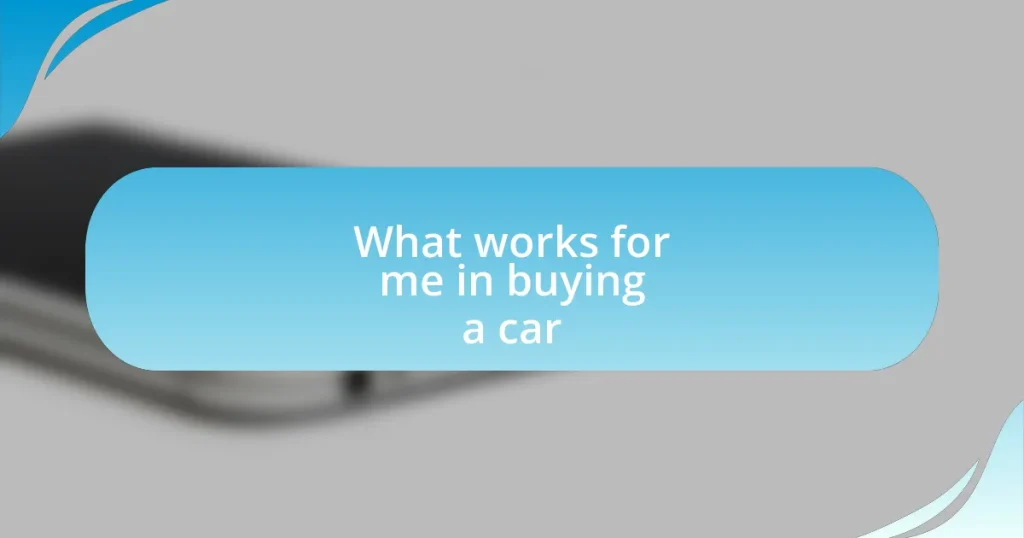Key takeaways:
- Dissatisfaction with a product or service often drives brand switching, influenced by personal experiences and innovation.
- Connecting with a brand’s values enhances loyalty and transforms purchases into meaningful experiences.
- Evaluating brand performance through quality, service, and transparency allows for informed consumer choices.
- Long-term brand satisfaction hinges on consistent quality and emotional connection rather than one-off positive experiences.

What motivates brand switching
One major reason people switch brands is dissatisfaction with the current product or service. I remember when I faced an issue with a popular coffee brand. After receiving a few bags of stale coffee beans, my trust was shaken, prompting me to seek alternatives that promised fresher quality and better taste.
Another motivator is the allure of innovation. When a new tech gadget hits the market, don’t we often feel that thrill of wanting to experience the latest features? I can recall switching from my old smartphone to a new model simply because it offered capabilities I never knew I wanted, like enhanced camera quality and faster processing.
Sometimes, external influences play a big role in brand decisions. Social media trends can create a sense of urgency, compelling us to try what’s popular. For instance, I’ve often found myself drawn to brands that my friends rave about online, wondering if I’m missing out on something truly game-changing. Isn’t it fascinating how collective enthusiasm can spur individual action?

Identifying personal values in brands
Identifying what truly matters to us in brands can be a profound journey. I’ve learned that when I connect with a brand’s values, it feels like a partnership rather than a purchase. For example, when I discovered a clothing brand focused on sustainable practices, it resonated deeply with my commitment to the environment. The feeling of wearing something that aligns with my beliefs brought a sense of pride and fulfillment that I hadn’t experienced before.
In my experience, a brand’s story plays a significant role in how I relate to it. When a brand openly shares its mission and values, I find myself more inclined to support it. I recall switching to a local bakery that not only produces delicious treats but also prioritizes community support. This alignment with my values made each bite feel like I was contributing to something bigger, transforming an ordinary purchase into a meaningful experience.
Identifying personal values in brands isn’t just about preferences; it’s a reflection of who we are. I believe that when a brand embodies ideals I cherish, my loyalty strengthens. Like when I transitioned to a tech company that champions user privacy — it’s an emotional assurance that my personal data is respected. These connections amplify our brand experiences, making them feel genuinely personal and significant.
| Personal Value | Brand Example |
|---|---|
| Sustainability | Eco-friendly clothing line |
| Community Support | Local bakery |

Evaluating brand performance comparisons
When I evaluate different brands, I often look at performance metrics to gauge their impact in my life. It’s fascinating how quantitative analysis intertwines with my emotions; for instance, after switching from one coffee brand to another, I noticed not just a taste difference, but also an improved morning routine that set a positive tone for my day. Tracking aspects like product quality, customer service, and brand responsiveness can really highlight what a brand brings to my experience.
To provide a clearer view of this evaluation, here are some key performance indicators I consider:
- Product Quality: Is the product reliable and meets my expectations?
- Customer Service: How responsive and helpful is the brand when I have inquiries or issues?
- Brand Transparency: Does the brand communicate openly about its practices and values?
- Community Engagement: How involved is the brand in supporting local initiatives or charities?
- User Experience: How easy is it to interact with the brand through various channels, online or offline?
These components give me a clearer picture of how well a brand aligns with my values and enhances my lifestyle, allowing me to make more informed choices as a consumer.

Experiencing brand loyalty impacts
When I reflect on my loyalty to a brand, it’s interesting how my attachment can morph into a profound experience. I remember when I switched to a local skincare line; the ritual of applying their products felt more intimate and personal. It wasn’t just about nourishing my skin; I found myself supporting a business that truly resonated with my values.
Feeling connected to a brand often leads to a sense of community. For example, I joined an online group centered around a new sportswear brand I started using. The shared experiences, tips, and even occasional complaints created a camaraderie that made me feel part of something larger. This bond naturally fosters a willingness to stick with a brand, even when alternatives are tempting.
However, brand loyalty doesn’t always mean sticking with the same product. I learned that being open to change can lead to better options that might surprise me. The first time I tried a competitor’s product, I hesitated—was I betraying my favorite brand? Ultimately, the realization that innovation is often found in unexpected places enriched my choices and expanded my horizons. Does that resonate with you?

Learning from brand transition challenges
Learning from brand transition challenges can be quite eye-opening. I remember when I decided to switch from a beloved coffee brand to a new, artisanal option. The first few mornings were awkward as I adjusted to the taste. I found myself questioning whether I had made a mistake—or if I was just being too picky about my morning ritual.
Going through this transition taught me the importance of patience. Initially, I missed the familiar flavor that had kickstarted my day for years. Yet, as I persisted, I began to appreciate the nuances of the new brand. This experience made me realize that some changes require time to develop a deeper appreciation, pushing me to look beyond immediate comfort.
The discomfort of switching brands also forced me to confront my attachment to familiarity. I started to wonder—what if all my preferences were simply habits? This introspection opened up new avenues for exploration, giving me the courage to embrace other changes in my life, whether in products or even lifestyle choices. It’s a continual reminder that sometimes, growth lies just beyond our comfort zone.

Integrating new brand experiences
Integrating new brand experiences can often feel like stepping into uncharted territory. I remember the first time I tried a new laundry detergent—its scent was completely different from what I had been using for years. At first, I was hesitant; did I really want to commit to this unfamiliar fragrance? But as I did my laundry and embraced the subtle freshness it brought, I found myself looking forward to the chore rather than dreading it.
What surprised me most was how quickly I began to associate that new scent with clean clothes and a sense of renewal. It led me to ponder: how often do we stick with the familiar simply out of routine? I realized this switch wasn’t just about a new product; it enriched my laundry experience, making it feel more like a refreshing ritual than a mundane task.
As I integrated this new brand into my life, I noticed my willingness to explore other changes grow. Whether it was trying out new recipes or experimenting with other household products, I felt a newfound bravery emerge. It became clear that embracing new experiences not only broadens our horizons but can also transform everyday moments into cherished rituals. Isn’t it fascinating how a simple switch in brands can ripple through various aspects of our lives?

Assessing long-term brand satisfaction
When evaluating long-term brand satisfaction, it’s essential to reflect on how consistently a brand meets our expectations over time. I’ve personally learned that my affinity for a brand often hinges on whether it continues to deliver quality and an emotional connection, rather than just a single positive experience. For example, after switching to a new coffee brand, I found that the taste was initially thrilling, but I later wondered if the same excitement would persist with each cup.
Over the months, I started to notice subtle shifts in how I felt about my morning ritual. Each cup began to evoke different emotions—sometimes it made my mornings feel invigorating, while other times, it just felt like caffeine dependence. I began to ask myself: Does the pleasure of sipping this coffee still match the comfort I once felt with my old favorite? This introspection taught me that true brand satisfaction goes beyond the product itself; it involves the entire experience it creates in my life.
Checking in on my feelings surrounding the brand, I realized that sticking with a product for the long haul was more about the relationship I built with the brand and less about mere convenience. There were moments when I craved the nostalgia of my previous brand, prompting me to examine what it was that appealed to me originally. This ongoing assessment of brand satisfaction has helped me understand my values more deeply, pushing me to choose brands that resonate with my life philosophy, rather than just those that are popular or easy to find.
















